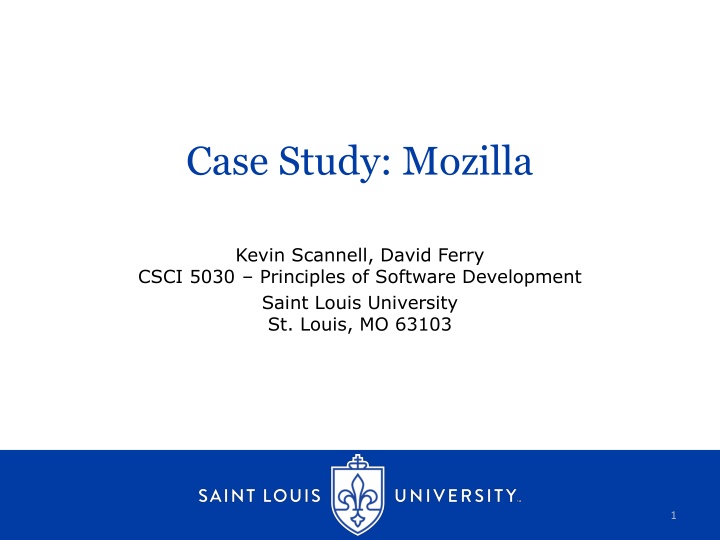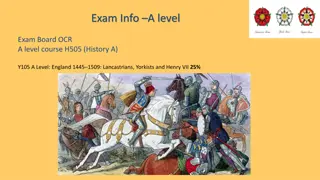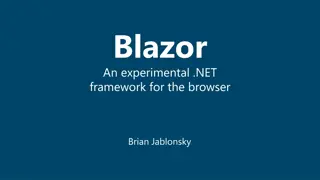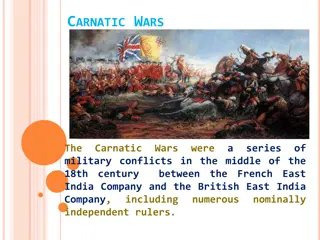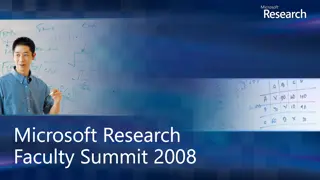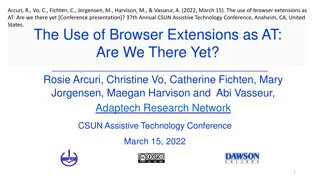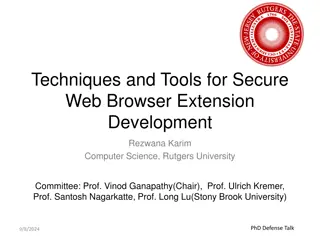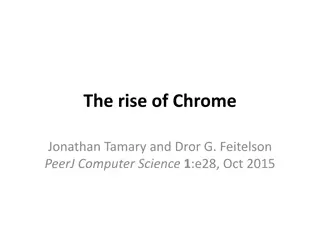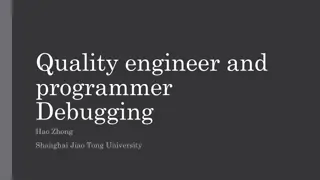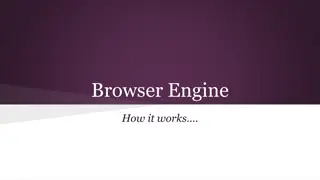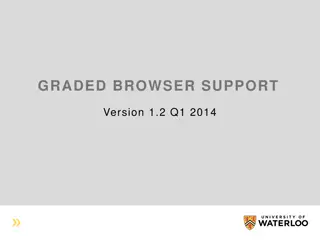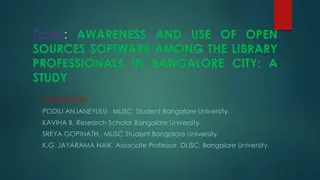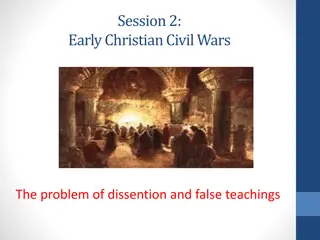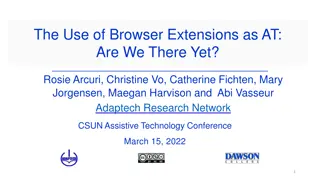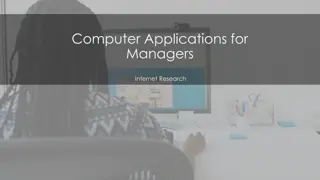Evolution of Mozilla: From Browser Wars to Open-Source Development
The evolution of Mozilla from the Browser Wars era to becoming a pioneer in open-source community development is highlighted. Starting with Mosaic and Netscape Navigator, Mozilla transformed into the popular Firefox browser and expanded into various projects under the Mozilla Foundation and Corporation. The repository structure, the vast codebase of Firefox, and the web browser reference architecture are discussed, showcasing Mozilla's impact on the software development landscape.
Download Presentation

Please find below an Image/Link to download the presentation.
The content on the website is provided AS IS for your information and personal use only. It may not be sold, licensed, or shared on other websites without obtaining consent from the author.If you encounter any issues during the download, it is possible that the publisher has removed the file from their server.
You are allowed to download the files provided on this website for personal or commercial use, subject to the condition that they are used lawfully. All files are the property of their respective owners.
The content on the website is provided AS IS for your information and personal use only. It may not be sold, licensed, or shared on other websites without obtaining consent from the author.
E N D
Presentation Transcript
Case Study: Mozilla Kevin Scannell, David Ferry CSCI 5030 Principles of Software Development Saint Louis University St. Louis, MO 63103 1
Mozillas Origins History: The Browser Wars Mosaic (1992) was the first big GUI web browser Developed by UI Urbana-Champaign Netscape Navigator (1994) quickly eclipsed Mosaic Netscape was the commercialization of Mosaic, included top Mosaic developers Microsoft IE (1995) enters the market and quickly becomes dominant Mozilla (1998) Netscape open-sources its application suite and forms an OSS community Firefox (2002) Standalone web browser CSCI 5030 Principles of Software Development 2
Browser Market Share Over Time https://commons.wikimedia.org/wiki/ File:Layout_engine_usage_share- 2009-01-07.svg CSCI 5030 Principles of Software Development 3
Mozilla Open-source community development But also the Mozilla Foundation But also the Mozilla Corporation Firefox Thunderbird Bugzilla Rust programming language Libraries like Network Security Services (NSS) Many others CSCI 5030 Principles of Software Development 4
Repository Browse: https://dxr.mozilla.org/mozilla- central/source/ All projects are combined into a single source tree Any project (Firefox, Thunderbird) can use features of other projects (e.g. NSS, OS-specific graphics, javascript engine) CSCI 5030 Principles of Software Development 5
Firefox Very large project: ~20,000 html files ~12,000 javascript files ~8,000 C/C++ files Also: .py, .java, .sh, .asm, many more In all- 8.85M lines of code, mostly in C/C++ CSCI 5030 Principles of Software Development 6
Web Browser Reference Architecture A. Grosskurth and M. W. Godfrey, "A reference architecture for Web browsers," 21st IEEE International Conference on Software Maintenance (ICSM'05), Budapest, Hungary, 2005, pp. 661-664. doi: 10.1109/ICSM.2005.13 A B means A depends on B Layered architecture Recall the 7-layer OSI model- higher level components rely on functionality provided by lower levels If API is stable layers can be built and tested in isolation Promotes reuse of components in other projects CSCI 5030 Principles of Software Development 7
Web Browser Reference Architecture A. Grosskurth and M. W. Godfrey, "A reference architecture for Web browsers," 21st IEEE International Conference on Software Maintenance (ICSM'05), Budapest, Hungary, 2005, pp. 661-664. doi: 10.1109/ICSM.2005.13 A B means A depends on B Networking: fetch URLs, deals with security (SSL, TLS, etc ), handles host-to-network and network-to-host translations, caching to minimize network traffic JS Interpreter: Executes .js code embedded in HTML, but also .js code running in browser (addons and more, etc.) CSCI 5030 Principles of Software Development 8
Web Browser Reference Architecture A. Grosskurth and M. W. Godfrey, "A reference architecture for Web browsers," 21st IEEE International Conference on Software Maintenance (ICSM'05), Budapest, Hungary, 2005, pp. 661-664. doi: 10.1109/ICSM.2005.13 A B means A depends on B XML Parser: parses structured markup languages, used both to parse web resources and also internally (config files, etc.) Display Backend: Primitive drawing and windowing methods. The main OS-dependent piece, hopefully everything else should be OS-independent. Keep this small and walled-off for portability! CSCI 5030 Principles of Software Development 9
Web Browser Reference Architecture A. Grosskurth and M. W. Godfrey, "A reference architecture for Web browsers," 21st IEEE International Conference on Software Maintenance (ICSM'05), Budapest, Hungary, 2005, pp. 661-664. doi: 10.1109/ICSM.2005.13 A B means A depends on B Rendering Engine: Creates visual representation of a URL. Interprets HTML, CSS, XML, .js as necessary and generates the layout that is displayed in the UI. A complex part and a testing problem- needs to balance handling of malformed HTML that appears in the wild with adherence to standards. CSCI 5030 Principles of Software Development 10
Web Browser Reference Architecture A. Grosskurth and M. W. Godfrey, "A reference architecture for Web browsers," 21st IEEE International Conference on Software Maintenance (ICSM'05), Budapest, Hungary, 2005, pp. 661-664. doi: 10.1109/ICSM.2005.13 A B means A depends on B Browser Engine: High level interface to rendering engine. Methods for loading a URL, reload, back, forward UI: What you re used to seeing and interacting with. The browser window and user interactions, but also addons manager, developer console, bookmarks, preferences dialog, print manager, download manager CSCI 5030 Principles of Software Development 11
Web Browser Reference Architecture A. Grosskurth and M. W. Godfrey, "A reference architecture for Web browsers," 21st IEEE International Conference on Software Maintenance (ICSM'05), Budapest, Hungary, 2005, pp. 661-664. doi: 10.1109/ICSM.2005.13 A B means A depends on B Data persistence: user profile, store bookmarks, passwords, cookies, form info, etc. CSCI 5030 Principles of Software Development 12
Firefox Architecture: Necko: Platform independent API for networking. Create an HTTP channel, get a URL over that channel, etc. NSS encryption, certificate validation, etc. SpiderMonkey written in C, independent of everything A. Grosskurth and M. W. Godfrey, "A reference architecture for Web browsers," 21st IEEE International Conference on Software Maintenance (ICSM'05), Budapest, Hungary, 2005, pp. 661-664. doi: 10.1109/ICSM.2005.13 Expat open source, outside project CSCI 5030 Principles of Software Development 13
Firefox Architecture: Display Backend: GTK/X11 on Linux, MFC on Windows, Aqua on Mac OSX Gecko: General layout engine for HTML, CSS, .js. Takes content and displays the formatted content on the screen. Paints the browser s content area. Used by more than just Firefox. A. Grosskurth and M. W. Godfrey, "A reference architecture for Web browsers," 21st IEEE International Conference on Software Maintenance (ICSM'05), Budapest, Hungary, 2005, pp. 661-664. doi: 10.1109/ICSM.2005.13 CSCI 5030 Principles of Software Development 14
Firefox Architecture: XPFE Cross Platform Front End builds and displays user interfaces based on HTML components and HTML-like components, CSS styling, and made interactive with JavaScript. No compilation or low-level coding required. A. Grosskurth and M. W. Godfrey, "A reference architecture for Web browsers," 21st IEEE International Conference on Software Maintenance (ICSM'05), Budapest, Hungary, 2005, pp. 661-664. doi: 10.1109/ICSM.2005.13 CSCI 5030 Principles of Software Development 15
Mozilla Development Methodology Module Ownership Governance System Module Owner leadership of module, responsible for code quality, revisions and innovations as appropriate, coordinating development with rest of Mozilla, documentation, etc. Peers- help do code reviews, review the module owner s contributions Firefox is a module (Dave Townsend owner, 63 peers) Can have submodules too- Thunderbird is divided into addressbook, compose, prefs, testing, etc. CSCI 5030 Principles of Software Development 16
Code Submission Most patches must be signed-off-on by the module owner or a peer of each affected module. Signing off-on means: I don t believe this patch does harm esp. security, performance, accessibility If problems arise because of this patch, I ll help fix it Test coverage is good Does not require best possible solution or style is 100% consistent remember that code review consumes the scarce high-cognitive effort time we have each day CSCI 5030 Principles of Software Development 17
Code Review Reviewers should have domain expertise, but there are no inherent limitations of what comments a reviewer might make Goal review does the patch fix a bug or solve the fundamental problem? API/design review changes to any API must conform to API rules, pass an API checklist, and meet naming guidelines Maintainability review readability, code style Security review meets security best practice, does this code need additional security testing such as fuzz testing or static analysis CSCI 5030 Principles of Software Development 18
Code Review Part 2 Integration review does this code work properly with other Mozilla modules, is it localized/internationalized, does it have any dependencies, does it have documentation? Testing review are there appropriate behavior tests and unit tests for error conditions and likely incorrect inputs? Performance review has the code been profiled, will this code impact other code performance? License review does the code follow the Mozilla licensing rules? CSCI 5030 Principles of Software Development 19
Rapid Release Cycle A new version is released every six weeks, there are four main branches: mozilla-central (nightlies, unstable) mozilla-aurora (experimental branch) mozilla-beta release Every six weeks there is merge day where code on aurora goes to beta and central goes to aurora No new features ever skip this cycle, all must bubble up from central Idea is that each level has 10x more users and is commensurately more stable CSCI 5030 Principles of Software Development 20
Testing Changes ready for mozilla-central will first land on mozilla-inbound. This branch merges with central about once per day There are users that use central s nightly builds, so you can t break their software Commits to inbound will kick off automated tests, and if anything bad happens it can be undone before merged to central Commit authors expected to be around for four hours after a commit Each tree has a sheriff that polices the tree and will yell at you or back out your changes if you aren t available ( keeps the trees green ) CSCI 5030 Principles of Software Development 21
Testing Part 2 Checkout live tests on: https://treeherder.mozilla.org Arcane Test Notation: B: compiled code tests X: xpcshell tests (JS tests, low level) J: JS engine tests C: crash tests (catalog of HTML pages that have crashed the browser in the past) R: reference tests (compares output of two HTML pages that should produce the same output) M: mochitest (plugin APIs, UI automation tests) T: Talos (performance testing) CSCI 5030 Principles of Software Development 22
